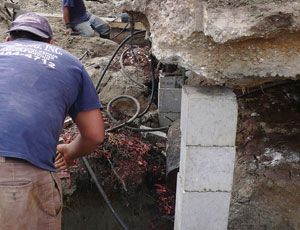Neither Bob Sternhell nor Bill Petty were interested in residential construction until the slow pace of re�building after Hurricane Katrina found them joining forces to elevate more homes around New Orleans than all other contractors combined.

Petty, president of the local division of Walton Construction Co., Kansas City, Mo., earlier this year formed Walton Mit�igation Services, a wholly owned Wal�ton subsidiary. He then joined with with Sternhell, CEO of Solutient Inc., a local information-technology firm, to form a risk-mitigation program-management joint venture. WMS and Solutient now have landed $182 million of the $1.4 billion of risk-mitigation grants offered to Louisiana homeowners since 2005, about two-thirds of which has yet to be awarded.
The Federal Emergency Management Agency’s hazard-mitigation grant program gives money to states and local governments to help homeowners reduce risk after major disasters. The scope ranges from installing storm shutters and elevating homes to demolition and buyouts. FEMA also has other non-disaster, risk-mitigation grant programs that the joint venture is addressing.
Sternhell has worked for several years on hazard-mitigation consulting and geographic-information systems as one of FEMA’s major floodplain mapping partners in Louisiana and Texas. With his construction expertise, Petty says they joined forces to help homeowners and local governments turn the complex and slow-moving grant opportunities into dirt-turning work while creating a business model that could work anywhere disaster aid flows.
“It’s been over three years since Katrina,” Petty says. “Everyone was crying that the Feds didn’t send money to help, and here we are with $1.4 billion in hazard-mitigation grants still sitting in Baton Rouge.”
“Our fee averages about 8.5% of the total dollars, which falls well within the FEMA guidelines,” adds Sternhell. “Of what has been spent, Solutient and Walton have done the vast bulk of work.”
In Jefferson Parish, the only contractors now used by the parish for program management are Solutient and the joint venture, says Tommy Rodrigue, flood- plain manager for unincorporated Jefferson Parish and FEMA’s chief agent for grants for the entire parish. He says owners of almost 300 homes have been awarded hazard-mitigation grants, and applications are in for another 170 under another FEMA risk-mitigation program.
Jefferson Parish was the first area in the state to receive such assistance, probably because Solutient was hired for program management, says Tim Coulon, a former parish president and now head of Coulon Consulting of Jefferson Parish, a government affairs adviser. Elevating homes is “part of the toolbox of little pieces, like building higher levees,” Coulon says. Adds Rodrigue, “These are the largest contracts I’ve had for mitigation in the eight years I’ve been in the parish.”
“The initial thrust of the [grant] award is to mitigate property and ultimately mitigate cost to taxpayers,” says Coulon. “The difficulty is in the minutiae of how the funding comes down.”
Elevating not only reduces risk, it reduces insurance costs for homeowners and benefits the National Flood Insurance Program, Rodrigue says. “When we put a home on a grant application, there is a benefit-cost analysis that must be performed to show that the grant is at least a 1:1 ratio compared to what future insurance payouts would be,” Rodrigue says. “In most cases, that ratio is [better].”
A recent study by the Multi-Hazard Mitigation Council suggests that $1 spent on mitigation saves society an average of $4, Petty says.


Post a comment to this article
Report Abusive Comment